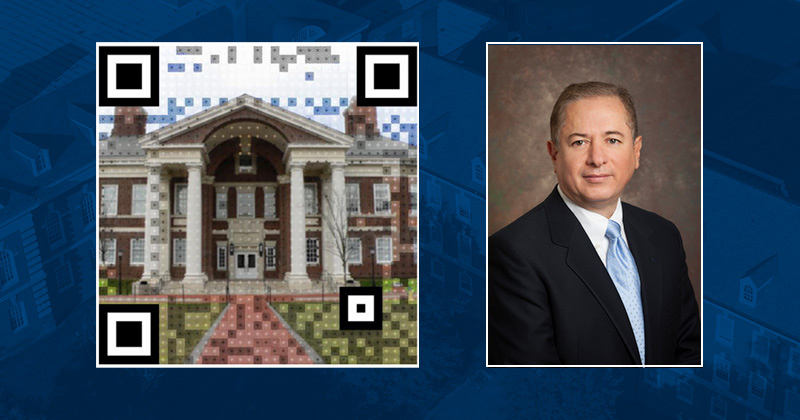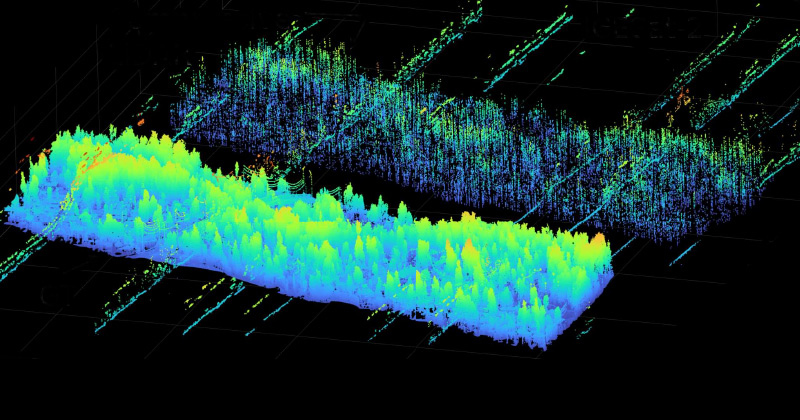


Campus innovator honored for inventions
Photo illustration by Jeffrey C. Chase December 08, 2022
UD’s Gonzalo Arce elected fellow of National Academy of Inventors
University of Delaware electrical and computer engineer Gonzalo Arce is an imaginative soul with a humble personality.
Behind this modest nature, however, is a driven and keen mind with a collaborative spirit.
A prolific innovator, Arce is an inventor on 25 patents spanning inventions with environmental, health care and technology applications, from the laser printer industry to smart QR codes to low-dose X-ray computer tomography imaging, which is now recommended as a screening test for adults at high risk of developing lung cancer.
Several of these patents have been licensed, and Arce’s work has led to two spin-off companies, Graphic Lead and LRC Solutions.
For these innovations and others, Arce, the Charles Black Evans Professor of Electrical Engineering at UD, has been elected a 2022 Fellow of the National Academy of Inventors.
The 2022 NAI Class of Fellows was announced Thursday, Dec. 8. It is the highest professional distinction accorded to inventors. The designation places Arce in company with other esteemed inventors, including members of the National Academies of Science, Engineering and Medicine, and senior leaders of research universities, governmental and nonprofit research institutes.
The NAI Fellows program highlights “academic inventors who have demonstrated a prolific spirit of innovation in creating or facilitating outstanding inventions” with tangible impact on life, the economy and society. Arce joins over 1,500 NAI fellows worldwide, including 45 Nobel Laureates, whose inventions have led to over 13,000 licensed technologies and 3,200 companies, and which have created over 1 million jobs.
Inventions with impact across multiple fields
Levi Thompson, dean of engineering, pointed to Arce’s contributions as outstanding examples of electrical engineering innovation and invention.
“Dr. Arce’s accomplishments as an innovator are well known on our campus, as are his leadership and scholarship,” said Thompson. “Of particular importance are his patents in QR codes that are now becoming standards in the industry.”
QR codes are a type of barcode created out of black and white squares. QR codes can be made to encode information, such as URLs, that can be read by a camera or smartphone. Arce’s patents on smart QR codes have application to the emerging QR-code payment market, which is expected to grow to a $30 billion industry by 2030. This includes QR-code methods to address issues in security and authentication, emerging and important areas in current QR-code technology development.
Arce’s entrepreneurial efforts also were instrumental in the commercialization of halftoning, a process used in the printing industry that leverages various sized dots to produce images rather than continuous imaging techniques.
“Dr. Arce’s inventions have had an impact on the laser printer industry which is a yearly U.S. $3.3 billion market supporting a wide range of industrial segments including packaging, textiles and office printing,” said Frances Galvin, senior technology transfer associate at UD’s Office of Economic Innovation and Partnerships.
Meanwhile, his patented work in computational imaging has had substantial impact on the field of medical imaging, particularly on the development of low-dose X-ray computer tomography imaging methods that allow rapid acquisition of spectral CT scans with high resolution at significantly lower doses of radiation exposure for patients. Low-dose computed tomography is now recommended as a screening test for adults who have a high risk of developing lung cancer based on their smoking history. The technology may also have an impact on cargo screening.
Innovation and imagination
Looking back, Arce said he has been exploring lenses, magnets and the physics of nature for as long as he can remember.
“I think I inherited my imaginative nature from my father,” he said.
He considers innovation and imagination to be cornerstones of positive change and called his selection for NAI fellowship a “great honor” and “tribute to the students and colleagues with whom I have worked.”
In addition to his post in the Department of Electrical and Computer Engineering, where he served as chair from 1999 to 2009, Arce is a JPMorgan Chase Senior Faculty Fellow at the Institute of Financial Services Analytics and an affiliated faculty member with UD’s Data Science Institute.
He is a fellow of the International Society for Optics and Photonics (SPIE) and a life fellow of the Institute of Electrical and Electronics Engineers (IEEE). He also is a Teaching Fellow of the American Society of Engineering Education and a senior member of OPTICA, formerly the Optical Society of America.
As a professor, Arce has advised over 90 master’s and doctoral students, including four doctoral students selected for the Allan P. Colburn Prize in Mathematical Sciences and Engineering, UD’s most prestigious doctoral dissertation award. Several of his current or former students are co-inventors on his patents.
“My approach to mentoring doctoral students has always been to form a team with bright students,” he said. “They learn a lot from me, but often, they also come with radically different perspectives that I will learn from. It’s a very rewarding experience.”
This kind of collaboration and imagination makes a great day at UD, he continued. And Arce has had many such days at UD.
“Who could have thought that, together with one of my doctoral students, we could refine the invention of the printing press 500 years later,” said Arce.
He also has been a driving force of partnerships with Colombian universities that has helped attract top doctoral students to UD through a global exchange program in engineering. Since the program’s inception in 2008, more than 30 doctoral students have enrolled in UD’s graduate program in engineering from a consortium of Colombian universities.
Arce’s research has been supported by the National Science Foundation, National Aeronautics and Space Administration, Army Research Laboratory, Office of Naval Research, Air Force Office of Scientific Research and Department of Homeland Security, among other agencies, as well as industry.
In one current project, Arce is working with NASA on environmental LiDAR imaging, including improved global sensing methods to understand Earth. LiDAR stands for light, detection and ranging, a remote sensing method that uses pulsed light to measure variable distances to Earth. Arce’s work involves developing machine learning methods to empower a new class of global LiDAR sensors from satellites to sparsely sample Earth from a distance of 350 kilometers (nearly 220 miles) above the planet and then leverage computational methods to reconstruct the data that’s been left out as if the sampling was done from a height of 350 meters, the equivalent of about 1,150 feet. It’s the type of imaging that can improve understanding of the natural and built world, to better understand the oceans and glaciers, flooding and forest health, and to provide high-resolution information about carbon cycling, volcanoes, land movement and urban structures.

A growing cohort of NAI fellows at UD
UD has a strong history of invention, which includes innovations by the late Richard Heck, a Nobel laureate and professor emeritus of chemistry, whose chemical synthesis discoveries, including the “Heck reaction,” led to advances in pharmaceuticals, genome sequencing and electronic display devices. Other UD inventors include John Elias and Wayne Westerman, founders of FingerWorks, the touchscreen technology used in today’s smart devices. Heck was elected an NAI fellow in 2015. Elias, professor of electrical and computer engineering, and Westerman, who earned a doctoral degree in electrical and computer engineering at UD, were named NAI fellows in 2013.
Additional UD faculty designated as NAI Fellows include Kelvin Lee , Gore Professor of Chemical Engineering and institute director for the National Institute for Innovation in Manufacturing Biopharmaceuticals (NIIMBL) and Thomas Epps, Allan and Myra Ferguson Distinguished Professor of Chemical and Biomolecular Engineering at UD with a joint appointment in Materials Science and Engineering (2021), Eleftherios (Terry) Papoutsakis, Unidel Eugene du Pont Chair of Chemical and Biomolecular Engineering (2020); Kristi Kiick, Blue and Gold Distinguished Professor of Materials Science and Engineering (2019); Yushan Yan, Henry Belin du Pont Chair of Chemical and Biomolecular Engineering and director of the Center for Clean Hydrogen at UD (2018); Dennis Prather, Engineering Alumni Professor of Electrical and Computer Engineering (2017); Norm Wagner, the Robert L. Pigford Chair in Chemical and Biomolecular Engineering (2015); the late Babatunde Ogunnaike, William L. Friend Chair of Chemical and Biomolecular Engineering (2014); and former UD President Patrick Harker (2012).
Contact Us
Have a UDaily story idea?
Contact us at ocm@udel.edu
Members of the press
Contact us at 302-831-NEWS or visit the Media Relations website

